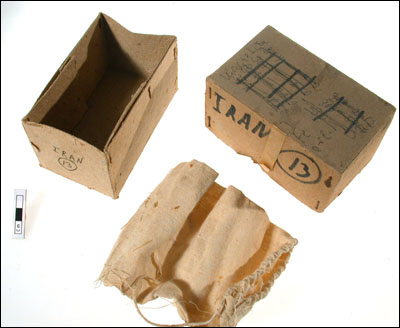The samples and their journey
2002- The collection includes: ceramic sherds, tuyères, ores, slag, furnace remains. A chance meeting between an Israeli archaeometallurgist and an Iranian student led to the transfer of the collection to the Institute of Archaeology, UCL, alongside field notes and site photographs by Beno Rothenberg, who had stored them for over thirty years. The metallurgical samples became the subject of an undergraduate dissertation (Roya Arab 2003)
 |
|
The original boxes from 1968 |
When the samples arrived at the IoA the original boxes were in a bad state, with crumbling barely legible tags. The artefats were housed at the Institute of Archaeology, with support from IAMS and Thilo Rehren. An effort was made to locate the various 1968 team members and to collect relevant written data (field notebooks, letters, unpublished and published reports). Reports sent by Radomir Pleiner, alongside reports and notes of R. Tylecote stored at the British Museum, were invaluable for providing site names to the numbers that were found on the boxes (Arab 2003).
- The samples were identified by Thilo Rehren. They were subsequently re-boxed, relabeled, photographed (#) and catalogued.
- The samples have been cross-referenced with an appendix of textual data: field notebooks, letters, taped interview, photographs, published and unpublished reports.
- The collection of samples are now stored alongside the appendix, and a catalogue created to make these samples available to scholars for study.
- This website is the final stage of making this collection more widely available to interested scholars. Iran Heritage Foundation facilitated the design of the website and digitisation of the catalogue by Xander Veldhuijzen.
1968
There was no coordinated sampling conducted by the group. As far as could be established from the participants, several members of the group collected material according to their own briefs and interests. The aims of the travelers are as disparate as the fates of the various samples collected.- “For a wrap up look at the region of the birth of Pyrotechnology” (Wertime, A1 ##)
- “Reconnaissance to locate and examine early metallurgical and other sites that have contributed to the Ancient Middle Eastern civilizations” (Tylecote, 1970, p285, E6)
- “Quick survey of a large number of early pyrotechnological sites, and to bring together in the field, persons from various appropriate disciplines” (Brill, A6)
- “Determine whether tin was present in amounts indicative of sources for tin ores used in antiquity” (Domenico et al, 1978, abstract, D2)
Klinger accumulated a systematic collection of rock and soil samples for his geological prospection work; Matson collected sherds of archaeological ceramics. Both Klinger and Matson took their collections to the United States, the ceramics are now in the Matson Museum in Philadelphia. The three archaeometallurgists collected slags, ores, furnace remains and other metallurgy-related material. The archaeometallurgical collection remained in Turkey, due to antiquity laws of the country. Rothenberg managed to meet the minister of mining who gave him a permit to export them.
Tylecote took some samples with him to England (analysis results are held in the textual appendix to the collection; source code: B17, B24). The remaining samples were left in Rothenberg’s store in Israel for safe keeping.
Matson, Brill, Tylecote and Pleiner had written preliminary reports soon after the expedition of which Pleiner thankfully had copies, Tylecote and Wertime had also published travel reports on the expedition. Whilst the pyrotechnological samples languished with no funding for analysis, the geological samples became the subject of a 267page report paid for by the ‘United States Department of the Interior Geological Survey’, the front page blurb explain the analysis thus: “Determine whether tin was present in amounts indicative of sources for tin ores used in antiquity……… but also afforded chemical and mineralogical data that were interpretable in the context of regional potential for other elements of current industrial use” (Domenico et al, 1978, abstract, D2).
The metallurgical samples are now available for study subject to the regulations of IoA, UCL Collections.
(#)Stuart Laidlaw re-photographed the collection for publication on this website, a much needed improvement on my undergraduate efforts.
(##) The Letter followed by numbers i.e A01, B11, are for use of the textual appendix. Where only a letter and number is seen these are unpublished texts included in the appendix. Where published material is included in the appendix, the reference will be followed by the appendix reference, i.e. D02, E03.
